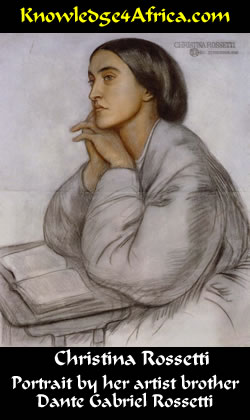|
READ THIS
The poet speaks about her secret. Perhaps she has a secret which nobody can see, perhaps she doesn't.
Either way, she is not going to tell.
Secrets are like articles of clothing, she says, or the door of a house. Clothing and doors serve a purpose:
to protect the person from the wind, rain and snow. So do secrets protect one. Perhaps she may
eventually allow a guess, although she may still not reveal the secret.
 ABOUT THE POET
ABOUT THE POET
Christina Rossetti was born in London in 1830, one of four children of Italian parents. Her father was the
poet Gabriele Rossetti while her brother was Dante Gabriel Rossetti who is famous as one of the founders
of the Pre-Raphaelite Brotherhood of artists.
Christina was the youngest of the siblings and had a lively intellectual mind, dictating her first story to her
mother before she had even learned to write.
She was educated at home and studied religious works, classics, fairy tales and novels. She was
surrounded at a very early age by the work of the great scholars and artists and, with her father being both
a revolutionary and a poet (he was a political exile from Italy), she met many of the visiting Italian scholars,
artists and revolutionaries.
In the 1840s, her family faced a severe financial crisis because of her father's deteriorating physical and
mental health. In 1843, he was diagnosed with persistent bronchitis (possibly tuberculosis) and also faced
going blind. He gave up his teaching at King's College and, though he lived another 11 years, he suffered
from depression and was never physically well again.
Christina's mother began teaching in order to keep the family out of poverty. Her siblings were also forced
to leave home to find work, leaving the teenaged Christina to a life of increasing isolation.
She suffered from nervous stress at age 14, and then depression followed afterwards. It was during this
period that religious devotion came to play a major role in her life. She had three offers of marriage from
distinguished artists while she was in her late teens but turned them all down on religious grounds.
Christina sat as the model for several of her brother's most famous paintings, e.g. as the Virgin Mary in
The Girlhood of Mary Virgin and again in his depiction of the Annunciation in Ecce Ancilla
Domini ("Behold, the handmaid of the Lord").
Her early poems were mostly imitations of her favourite poets but in her late teens she began
experimenting with verse forms, while drawing narratives from the Bible, from folk tales and from the lives
of the saints.
Her early pieces often featured meditations on death and loss. Her first two poems ("Death's Chill
Between" and "Heart's Chill Between"), were published when she was 18.
When she was about 20, she contributed seven poems to the Pre-Raphaelite journal The Germ
under the pseudonym "Ellen Alleyne".
Her most famous collection, Goblin Market and Other Poems, appeared in 1862 when she was 31.
It received widespread critical praise, establishing her as the main female poet of her time.
In the later part of her life, Christina suffered from Graves Disease which is a thyroid disorder. In 1893
she also developed breast cancer and, though the tumour was removed, she suffered a recurrence in
1894. She died in December that year. She was 64 years of age.
Christina Rossetti is increasingly being reconsidered a major Victorian poet, compared to the great
American poet Emily Dickinson.
Have you looked at the questions
in the right column?
|
TEST YOURSELF!
Read the left column and then answer
the following questions:
Would you like to comment on the structure of this poem? (10)

[Need help?]
The verses are flexible in length, with Stanza 1 having six lines, Stanza 2 with sixteen, Stanza 3 having
only five and Stanza 4 with seven. The lengths of each line also varies.
The rhyme too has an experimental structure. There is indeed a rhyming scheme but it is a loose one and
not fixed by any conventions:
ABBACC
DEDFEGGEHHEBBBII
JJKKK
FLLMMFL
Together with the flexible rhyming, there is also a marked use of ASSONANCE which is the use of
rhyming words within the line:
"it froze, and blows and snows";
"Come bounding and surrounding me, | Come buffeting, astounding me";
"Nipping and clipping";
"who ever shows | His nose to Russian snows".
All of this results in a fun poem. It's meant to be bright and humourous, narrated with a laugh and a smile
and is meant to get the listener to smile as well.
Can you see anything else?
|
"I tell my secret? No indeed, not I:
Perhaps some day, who knows?
But not today; it froze, and blows and snows,
And you're too curious: fie!
You want to hear it? well:
Only my secret's mine, and I won't tell."
- If you were to read this verse out loud, what tone of voice would you use? Why? (4)

[Need help?]
This verse is meant to be light-hearted, and spoken with exaggerated expression. There is nothing
serious here.
Throughout this verse there are exaggerated expressions: "No indeed, not I" and "And you're too curious:
fie!" Indeed, the word "fie!" is so out of place in serious conversation.
|
- Will the poet ever divulge her secret? (2)

[Need help?]
Perhaps she will divulge her secret, one day. But certainly not now.
|
- The poet gives two reasons why she will not reveal her secret. What are they? (4)

[Need help?]
The poet introduces her image of a secret as being like articles of clothing which are meant to keep the
person warm and dry. It's too cold, she says. The time is not right for discarding her clothing. The time
is also not right for revealing her secret.
In any case, she says, the person is being too curious, too impertinent in asking. If she is going to reveal
her secret, it must be when the time is right and not to some casual, curious questioner.
|
"Or, after all, perhaps there's none:
Suppose there is no secret after all,
But only just my fun"
- What point is the poet making in these three lines? (4)

[Need help?]
The person, the poet says, is being too curious in asking the secret. Perhaps there's no secret at all.
Perhaps the poet is simply having fun, pretending that she's hiding a secret when in fact she isn't.
|
"Today's a nipping day, a biting day;
In which one wants a shawl,
A veil, a cloak, and other wraps:
I cannot ope to everyone who taps,
And let the draughts come whistling thro' my hall"
- What does the poet mean when she says "Today's a nipping day, a biting day; | In which one wants
a shawl, | A veil, a cloak, and other wraps"? (4)

[Need help?]
The poet introduces her image: a secret is like clothing. Clothing serves a purpose, to protect the body
from the various weathers. A secret is meant to protect the inner person.
|
- What do "shawl", "veil" and "cloak" have in common? (4)

[Need help?]
A "shawl", "veil" and "cloak" are all articles of clothing worn as extras which protect different parts of the
body. It is not just ordinary clothing which is worn for modesty.
A shawl goes over the head, a veil protects the face whereas a cloak goes over the shoulders.
|
- What would the difference be between a "nipping day" and a "biting day" day? (4)

[Need help?]
A "nipping day" is one where it is cold whereas a "biting day" is one where it is VERY cold.
|
- The poet uses a different image when she says, "I cannot ope to everyone who taps". Explain what
this is. (4)

[Need help?]
The poet has up till now compared a secret to articles of clothing meant to protect the body from the
weather. Now she speaks of a secret as being like the door of a house, where the closed door protects
one from the blizzard outside. One cannot open the door to everyone who knocks, she says, and allow
the blizzard to howl through the hallway.
|
|



